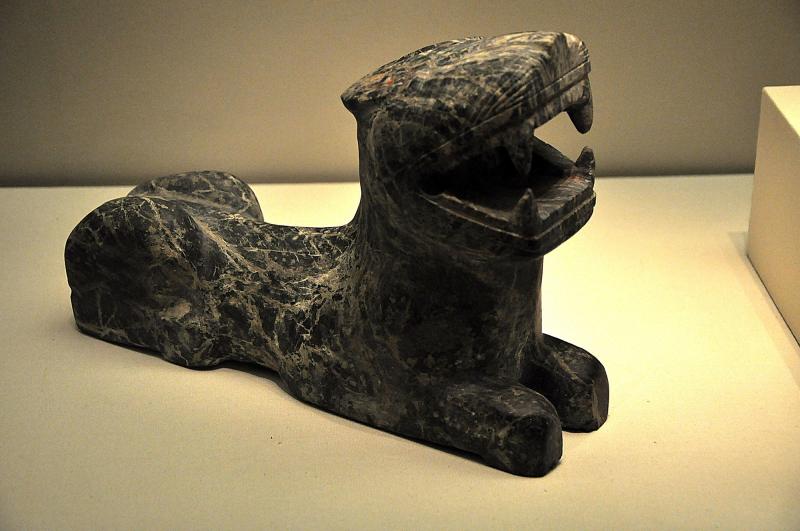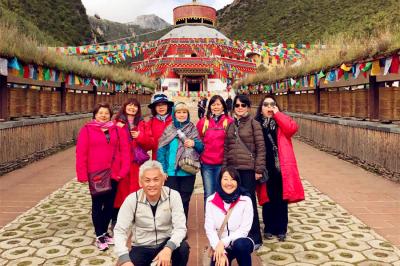Jinsha Cultural Relics Museum
Jinsha Cultural Relics Museum (Jinsha Site Museum) was built on the basis of the Jinsha relic which was discovered in Feb, 2001, with an area of 38000 square meters (74 acres). The Jinsha Site was the most significant archaeological discovery in the 21st century in China. Thousands of gold plates, jade articles, stone wares, bronze wares and ivories of Kingdom of Shu (221 - 263) were discovered from the site. Among them the Holy Bird, which is the combination of the ancestors’ philosophy, rich imagination, excellent art creation and superb skills, has become the symbol of China Cultural Heritage. After Ancient Shu Kingdom`s disappearance from over 3,000 years ago, Jinsha Ruins is considered to be another capital of it. Today Jinsha Ruins has been a key national cultural relic protection project.
In Nov, 2004, the Jinsha Site Museum began to be built on the site. It opened to the public as an advanced, world first-class museum. Moreover, it has been listed as the sixth series of Cultural Relics of National Importance under the Protection of the State. Jinsha Site Museum is made up of five sections: Relic Hall, Exhibition Hall, Protection Center of Cultural Relics, Garden District and Tourist Receiving Center. It not only displays the history of the origin, development, evolution of the ancient Shu dynasty, but also reappear the ecological and living environment as well as the worship styles. Thus, visitors can appreciate the magnificent worship and exquisite relics of ancient Shu Kingdom 3000 years ago. Related performances and activities all year around are available at academic report center and 4D cinema.

Jinsha Cultural Relics Museum Facts
Chinese Name: 金沙遗址博物馆
Location: No.2, Jinsha Site Road, Qingyang District, Chengdu, Sichuan Province, China. 四川省成都市青羊区金沙遗址路2号
Entrance Fee/ticket of the Wenshu Monastery: RMB80.
Opening Hours: May-Oct / Tue-Fri 9:00-18:00(last admission at 17:00); Sat-Sun 9:00-20:00 (last admission at 19:00). Other months / Tue-Sun 9:00-18:00(last admission at 17:00).
Note: The museum is closed on Mondays except for January, February, July and August.
Airport: Chengdu Shuangliu Airport
What to see at Jinsha Site Museum?
The Chengdu Jinsha Site Museum has a total of 2,235 pieces (sets) of cultural relics in the collections of gold, bronze, jade, stone, lacquered, pottery, and ivory. Among them, there are 366 first-class cultural relics (sets), 374 second-class cultural relics (sets) and 1,429 third-class cultural relics (sets).
Sun and Immortal Birds Gold Ornament
Among all collections, the Sun and Immortal Birds Gold Ornament is outstanding. With a circular appearance, its outer diameter is 12.53cm, the inner diameter is 5.29cm, and the thickness is 0.02cm. The Gold Ornament is divided into inner and outer layers, both of which we can find hollow patterns. The inner pattern is like the sun rotating in the sky, also like a helical saw blade. The outer pattern consists of four identical birds flying counterclockwise. They are equally spaced around the inner rotating sun. The birds stretch their necks and legs, and fly with three toes in the same direction. Various processing methods such as pounding, shearing and polishing were used on the piece of Gold Ornament. The front side is polished and bright, and the backside is rough without polishing. This golden Sun and Bird piece means a lot in history, art and science. It is valuable for studying the gold craftsmanship, bronze civilization and deep-level ideology of ancestors in that area in the Shang and Zhou Dynasties (about 1046 BC).

Gold Mask
Of all collections at Jinsha Site Museum, the Gold Mask can’t be missed . Its size is not very big, with length 20.5cm, width 10.4cm, height 10.7cm, thickness 0.08cm. The whole mask is made of gold, which is a three-dimensional facial mask. We believe it was formed by beating on a mold. The eyes, nose, mouth and ears were carved out. The face is shaped a bit like rectangle. The forehead is flat, the eyebrows are slightly raised, and the eye sockets are large, the eyes are hollow-carved. The bridge of the nose is high and straight. The mouth is hollowed out, slightly open, narrow and rectangular, slightly smiling. The ears are wide at the top and narrow at the bottom and there’s a hole on each earlobe. The whole face is plump and majestic, in a certain realistic style. The surface of the Gold Mask is polished and bright, and the inside is not rough. Through this relic piece, we can date back to thousands year ago, to explore the ancient civilization. It says that the gold processing technology, bronze civilization started very long ago and played an important role.
Stone Tiger
The Stone Tiger is one of the finest stone collections of Jinsha Site Museum. Its size is small, with length 28 cm, width 8.88 cm, height 20.03 cm. The natural markings of the stone with a large number of gray-white stripes are close to tiger skin, which make the tiger more vivid. The crouching tiger’s head is holding up, with its eyes looking up, mouth wide open. In its mouth, we can see four big teeth. The head and neck of the tiger are larger than the body, which is a kind of super-realism. Its forelimbs are stretching forward, and legs are bending forward on the ground. The stone tiger looks fierce with its opening big mouse, very natural and unadorned. The Stone Tiger is considered to be a rare stone round carving art masterpiece in the Shang and Zhou Dynasties.

How to get to Jinsha Site Museum?
By Metro Line: take line No.7 and get off at Jinsha Museum station (金沙博物馆站).
By public bus: take bus No. 82、83、100、111、142、163、211、1029、1043, get off at Jinsha Yizhi Dongmen stop (金沙遗址东门站) and walk for around 200m.
Travel Tips
1. Please do not touch the exhibits, and do not use wheeled shoes in the hall.
2. Do not bring flammable, explosive, toxic materials and not-allowed tools into the hall.
3. Please store your luggage before entering the exhibition hall, and keep your valuables properly.
4. In order to better the display effect, the light of the exhibition hall is a bit dark. Please pay attention to your safety.


